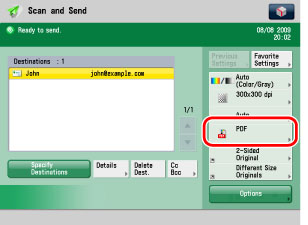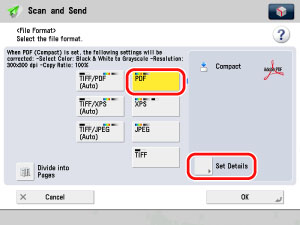This mode enables you to convert the text and line drawings of a scanned image to scalable outline data. The extracted outline data can be used in Adobe Illustrator. The smoothing process can also be applied to the text of the outline data, so it has less of a jagged edge when seen on a computer monitor or in print.
If you select [Trace & Smooth] as the PDF file format, [Compact] is automatically set to 'On'. You can also set [OCR(Text Searchable)]. The Trace and Smooth mode cannot be set by itself. If you select [Trace & Smooth], [PDF(Trace&Sm.)] is displayed as the file format on the Scan and Send Basic Features screen.
For information on the optional products required to use this function, see "Optional Products Required for Each Function."
|
IMPORTANT
|
|
If you send a trace and smooth PDF, select any of the following combination of a colour mode and resolution:
Auto (Color/Gray) and 300 × 300 dpi
Full Color and 300 × 300 dpi
Grayscale and 300 × 300 dpi
Long strip originals (432 mm or longer) cannot be used with the Trace & Smooth mode.
If you set the Trace & Smooth mode, the machine automatically recognizes which parts of the document are text or line drawings. the machine may not recognize which parts of the scanned document are text and line drawings correctly, depending on the scanned document.
If you set the Trace & Smooth mode, smoothing is only performed on the areas of the document that are correctly recognized as text.
The text and background of a PDF containing outline data may become misaligned or text and line drawings may not be displayed when opened in Adobe Illustrator, depending on the version of Adobe Illustrator used to open the PDF.
|
|
NOTE
|
|
If PDF(Trace & Smooth) is selected as the file format, you can only send at a copy ratio of [1:1(100%)] or [Auto].
The Trace & Smooth mode cannot be set by itself. If you select [Trace & Smooth], [Compact] is automatically set to 'On'.
|
1.
Place your originals and specify the destination → press the File Format button.

2.
Press [PDF] → [Set Details].
If [Set Details] is not displayed, press [Trace & Smooth] on the File Format screen → proceed to step 4.

3.
Press [Trace & Smooth] → [OK].

4.
Specify whether to divide your documents into separate pages → press [OK].
If you want to separate multiple images and send them as separate files, each of which consists of only one page, press [Divide into Pages].
If you want to send multiple images as a single file without dividing them, do not press [Divide into Pages].
|
IMPORTANT
|
|
If [Trace & Smooth] is selected for the PDF file format, the resolution is automatically changed to [300×300 dpi]. If the colour mode is set to [Auto(Color/Black)] or [Black & White], the colour mode is automatically changed to [Auto(Color/Gray)] or [Gray], respectively. If you want to send the document with the resolution setting and the colour mode that you specify, change the PDF file format to anything other than [Trace & Smooth] or [Compact].
If [PDF(Trace&Sm.)] is registered as the standard file format and you are sending documents by fax or I-fax, a message prompting you to change the file format may appear on the screen. In this case, change the file format to anything other than PDF(Compact) or PDF(Trace&Sm.). For more information on registering/changing the standard mode, see [Change Default Settings] in Common Settings in Send in Function Setting (Settings/Registration). (See "Changing the Default Settings for Send.")
If [PDF(Trace&Sm.)] is selected as the file format, documents can be sent only at a zoom ratio of 100%.
|
|
NOTE
|
|
To view a PDF file or to search a text in a PDF file, software that supports the PDF format (such as Adobe Reader/Adobe Acrobat) is required.
|